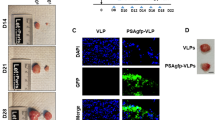Abstract
We used the bioluminescent human prostate carcinoma cell line PC-3M-luc-C6 to non-invasively monitor in vivo growth and response of tumors and metastasis before, during and after treatments. Our goal was to determine the utility of a luciferase-based prostate cancer animal model to specifically assess tumor and metastatic recurrence in vivo following chemotherapy. Bioluminescent PC-3M-luc-C6 cells, constitutively expressing luciferase, were implanted into the prostate or under the skin of mice for primary tumor assessment. Cells were also injected into the left ventricle of the heart as an experimental metastasis model. Weekly serial in vivo images were taken of anesthetized mice that were untreated or treated with 5-fluorouracil or mitomycin C. Ex vivo imaging and/or histology was used to confirm and localize metastatic lesions in various tissues initially detected by images in vivo. Our in vivo data detected and quantified early inhibition of subcutaneous and orthotopic prostate tumors in mice as well as significant tumor regrowth post-treatment. Local and distal metastasis was observed within seven days following intracardiac injection of PC-3M-luc-C6 cells. Differential drug responses and metastatic tumor relapse patterns were distinguished over time by in vivo imaging depending on the metastatic site. The longitudinal evaluation of bioluminescent tumor and metastatic development within the same cohorts of animals permitted sensitive and quantitative assessment of both primary and metastatic prostate tumor response and recurrence in vivo.
Similar content being viewed by others
References
Dalton WS. Detection of multidrug resistance gene expression in multiple myeloma. Leukemia 1997; 11(7): 1166–9.
Chaudhary KS, Abel PD, Lalani EN. Role of the Bcl-2 gene family in prostate cancer progression and its implications for therapeutic intervention. Environ Health Perspect 1999; 107 (Suppl 1): 49–57.
Hirsch-Ginsberg C. Detection of minimal residual disease: Relevance for diagnosis and treatment of human malignancies. Annu Rev Med 1998; 49: 111–22.
Resor L, Bowen TJ, Wynshaw-Boris A. Unraveling human cancer in the mouse: recent refinements to modeling and analysis.Hum Mol Genet 2001; 10(7):669–75.
Gambhir SS. Molecular imaging of cancer with positron emission tomography.Nat Rev Cancer 2002; 2(9): 683–93.
Contag PR.Whole-animal cellular and molecular imaging to accelerate drug development. Drug Discov Today 2002; 7(10): 555–62.
Weissleder R.Scaling down imaging: Molecular mapping of cancer in mice.Nat Rev Cancer 2002; 2(1):11–8.
Adams JY, Johnson M, Sato Met al. Visualization of advanced human prostate cancer lesions in living mice by a targeted gene transfer vector and optical imaging. Nat Med 2002; 8(8): 891–7.
Contag CH, Jenkins D, Contag PR, Negrin RS. Use of reporter genes for optical measurements of neoplastic disease in vivo.Neoplasia 2000;2(1-2): 41–52.
Edinger M, Cao YA, Hornig YS et al. Advancing animal models of neoplasia through in vivo bioluminescence imaging. Eur J Cancer 2002; 38(16):2128–36.
Laxman B, Hall DE, Bhojani MS et al. Noninvasive real-time imaging of apoptosis. Proc Natl Acad Sci USA 2002; 99(26): 16551–5.
Rehemtulla A, Stegman LD, Cardozo SJ et al. Rapid and quantitative assessment of cancer treatment response using in vivo bioluminescence imaging.Neoplasia 2000; 2(6): 491–5.
Vooijs M, Jonkers J, Lyons S, Berns A. Noninvasive imaging of spontaneous retinoblastoma pathway-dependent tumors in mice. Cancer Res 2002; 62(6): 1862–7.
El Hilali N, Rubio N, Martinez-Villacampa M, Blanco J. Combined noninvasive imaging and luminometric quantification of luciferaselabeled human prostate tumors and metastases. Lab Invest 2002; 82(11):1563–71.
Arguello F, Furlanetto RW, Baggs RB et al. Incidence and distribution of experimental metastases in mutant mice with defective organ microenvironments (genotypes Sl/Sld and W/Wv). Cancer Res 1992; 52(8): 2304–9.
Auerbach R, Morrissey LW, Sidky YA. Regional differences in the incidence and growth of mouse tumors following intradermal or subcutaneous inoculation.Cancer Res 1978;38(6): 1739–44.
Stephenson RA, Dinney CP, Gohji K et al. Metastatic model for human prostate cancer using orthotopic implantation in nude mice. J Natl Cancer Inst 1992; 84(12): 951–7.
Fidler IJ, Wilmanns C, Staroselsky A et al. Modulation of tumor cell response to chemotherapy by the organ environment.Cancer Metastasis Rev 1994; 13(2): 209–22.
Greene GF, Kitadai Y, Pettaway CA et al.Correlation of metastasisrelated gene expression with metastatic potential in human prostate carcinoma cells implanted in nude mice using an in situ messenger RNA hybridization technique. Am J Pathol 1997; 150(5): 1571–82.
Abate-Shen C, Shen MM. Mouse models of prostate carcinogenesis.Trends Genet 2002; 18(5): S1–5.
van Weerden WM, Romijn JC. Use of nude mouse xenograft models in prostate cancer research. Prostate 2000; 43(4): 263–71.
Sweeney TJ, Mailander V, Tucker AA et al. Visualizing the kinetics of tumor-cell clearance in living animals.Proc Natl Acad Sci USA 1999; 96(21):12044–9.
Kozlowski JM, Fidler IJ, Campbell D et al.Metastatic behavior of human tumor cell lines grown in the nude mouse. Cancer Res 1984;44(8):3522–9.
Author information
Authors and Affiliations
Corresponding author
Rights and permissions
About this article
Cite this article
Jenkins, D.E., Yu, SF., Hornig, Y.S. et al. In vivo monitoring of tumor relapse and metastasis using bioluminescent PC-3M-luc-C6 cells in murine models of human prostate cancer. Clin Exp Metastasis 20, 745–756 (2003). https://doi.org/10.1023/B:CLIN.0000006817.25962.87
Issue Date:
DOI: https://doi.org/10.1023/B:CLIN.0000006817.25962.87




